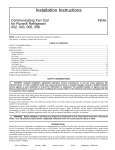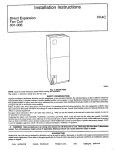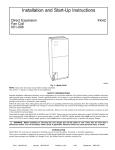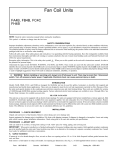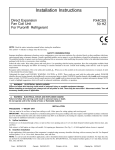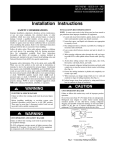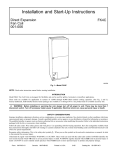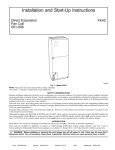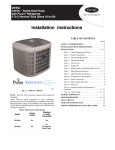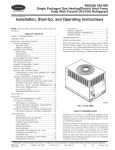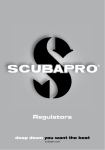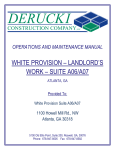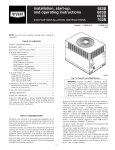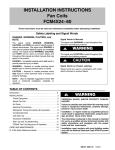Download Installation Manual
Transcript
FV4C 002, 003, 005, 006 Fan Coil for Puronr Refrigerant Installation Instructions SAFETY CONSIDERATIONS Improper installation, adjustment, alteration, service, maintenance, or use can cause explosion, fire, electrical shock, or other conditions which may cause death, personal injury or property damage. Consult a qualified installer, service agency, or your distributor or branch for information or assistance. The qualified installer or agency must use factory--authorized kits or accessories when modifying this product. Refer to the individual instructions packaged with the kits or accessories when installing. Follow all safety codes. Wear safety glasses, protective clothing, and work gloves. Use quenching cloth for brazing operations. Have fire extinguisher available. Read these instructions thoroughly and follow all warning or cautions included in literature and attached to the unit. Consult local building codes and the current editions of the National Electrical Code (NEC) NFPA 70. In Canada, refer to the current editions of the Canadian Electrical Code CSA C22.1. on Recognize safety information. When you see this symbol the unit and in instructions or manuals, be alert to the potential for personal injury. Understand the signal words DANGER, WARNING, CAUTION, and NOTE. These words are used with the safety--alert symbol. DANGER identifies the most serious hazards which will result in severe personal injury or death. WARNING signifies hazards which could result in personal injury or death. CAUTION is used to identify unsafe practices which may result in minor personal injury or product and property damage. NOTE is used to highlight suggestions which will result in enhanced installation, reliability, or operation. WARNING ! ELECTRICAL SHOCK HAZARD Failure to follow this warning could result in personal injury or death. A02332 Fig. 1 -- Model FV4C NOTE: Read the entire instruction manual before starting the installation. Before installing or servicing system, always turn off main power to system. There may be more than one disconnect switch. Tag disconnect switch with a suitable warning label. Turn off accessory heater power if applicable. ! CAUTION CUT HAZARD Failure to follow this caution may result in personal injury. Sheet metal parts may have sharp edges or burrs. Use care and wear appropriate protective clothing and gloves when handling parts. INTRODUCTION Model FV4C Fan Coil units are designed for flexibility and can be used for upflow, horizontal, or downflow (kits required on manufactured and mobile home) applications. These units are designed specifically for Puronr refrigerant (R--410A) and must be used only with Puron air conditioners and heat pumps as shipped. These units are designed to meet the low air leak requirements currently in effect. Because of this, the units need special attention in the condensate pan and drain connection area and when brazing tubing. These units are available for application in systems of 18,000 through 60,000 Btuh nominal cooling capacities. Factory--authorized, field--installed electric heater packages are available in 5 through 30 kW. See Product Data for available accessory kits. FV4C INSTALLATION Procedure 1 — CHECK EQUIPMENT Unpack unit and move to final location. Remove carton taking care not to damage unit. Inspect equipment for damage prior to installation. File claim with shipping company if shipment is damaged or incomplete. Locate unit rating plate which contains proper installation information. Check rating plate to be sure unit matches job specifications. Procedure 2 — MOUNT FAN COIL Unit can stand or lie on floor, or hang from ceiling or wall. Allow space for wiring, piping, and servicing unit. IMPORTANT: When unit is installed over a finished ceiling and/or living area, building codes may require a field--supplied secondary condensate pan to be installed under the entire unit. Some localities may allow the alternative of running a separate, secondary condensate line. Consult local codes for additional restrictions or precautions. When installing any fan coil over a finished ceiling and/or living area, installation of a secondary drain pan under entire unit to avoid damage to ceiling is recommended. FV4C Fan Coils can be installed for upflow and horizontal--left applications as factory shipped. Units can be installed for horizontal--right applications with field modifications. Units may be converted for downflow applications using factory--authorized accessory kits. NOTE: To ensure proper drainage for horizontal installations, unit must be installed so it is within 1/8 in. (3.2mm) level of the length and width of unit. A. Upflow Installation If return air is to be ducted, install duct flush with floor. Set unit on floor over opening. Only use return--air opening provided. All return air must pass through the coil. (See Fig. 2.) FIELD SUPPLIED SUPPLY DUCT POWER ENTRY OPTIONS LOW VOLT ENTRY OPTIONS 002 - 17.5" (444.5 mm) 003, 004, 005 - 21" (533.4 mm) 006 - 24" (609.6 mm) FRONT SERVICE CLEARANCE A COIL UNITS UPFLOW/DOWNFLOW SECONDARY DRAIN 1.5” (38.1mm) 19" (482.6 mm) UPFLOW/DOWNFLOW PRIMARY DRAIN 19" (482.6 mm) 2.5” FIELD MODIFIED (63.5 mm) SIDE RETURN LOCATION FOR 003 UNITS ONLY UPFLOW/DOWNFLOW SECONDARY DRAIN UPFLOW/DOWNFLOW PRIMARY DRAIN FIELD SUPPLIED RETURN PLENUM A09243 Fig. 2 -- Slope Coil Unit in Upflow Application 2 A-COIL HORIZONTAL LEFT PRIMARY DRAIN SECONDARY DRAIN FIELD SUPPLIED HANGING STRAPS FRONT SERVICE CLEARANCE (Full face of unit) UNIT 002-005 21" (533 mm) 006 24" (610 mm) FV4C LOW VOLT ENTRY OPTIONS 1 3/4" (44 mm) FILTER ACCESS CLEARANCE PRIMARY DRAIN SECONDARY DRAIN POWER ENTRY OPTIONS A09323 Fig. 3 -- Slope Coil in Horizontal--Left Application (Factory Ready) A COIL BRACKET FA CT OR Y SHIPPED HORIZONTAL LEFT APPLICATION COI L SUPPORT RAIL B C DRAIN PA N SUPPORT BRACKET COIL BRACKET HORIZONTAL DRAIN PAN PRIMARY DRAIN HORIZONTAL LEFT AIR SEAL ASSEMBLY SECONDARY DRAIN HORIZONTAL LEFT REFRIGERANT CONNECTIONS A00072 Fig. 4 -- A--Coil in Horizontal--Left Application (Factory Ready) 3 B. Modular Units The FV4C Fan Coil in sizes 003, 005 and 006 are available in 2--piece modular construction. Modular construction allows installer to disassemble unit into 2 components, coil box and blower box, for ease of installation. (See Fig. 3.) To disassemble unit, remove rear corner brackets by removing 2 screws which secure brackets. Remove either 2 screws in each front corner of coil box, or 2 screws in blower box. Do not remove all 4 screws in each corner. Sections may now be separated by lifting top section from lower section. To reassemble, reverse above procedure. Be certain to reinstall all fasteners when reassembling. C. Horizontal Installations Be sure installation complies with all applicable building codes that may require installation of a secondary condensate pan. 1. Arrange support for unit by setting it in or above secondary condensate pan. 2. When suspending unit from ceiling dimples in casing indicate proper location of screws for mounting metal support straps. (See Fig. 4.) D. Horizontal--Right Conversion of Units with Slope Coils ! CAUTION PROPERTY DAMAGE HAZARD Failure to follow this caution may result in property damage. FV4C Gasket kit number KFAHD0101SLP is required for horizontal slope coil conversion to maintain low air leak/low sweat performance. BLOWER BOX 2 SCREWS 2 SCREWS REAR CORNER BRACKET 2 SCREWS COIL BOX A95293 Fig. 5 -- Modular Unit Assembly 1. Remove blower and coil access panels and fitting panel. (See Fig. 5.) 2. Remove screw securing coil assembly to right side casing flange. 3. Remove coil assembly. 4. Lay fan coil on its right side and reinstall coil assembly with condensate pan down. (See Fig. 5.) 5. Attach coil to casing flange using previously removed coil mounting screw. 6. Make sure the pan cap in the fitting door is properly seated on the fitting door to retain the low air leak rating of the unit. 7. Add gaskets from kit KFAHD per kit instructions. 8. Reinstall access panels and fitting panel, aligning holes with tubing connections and condensate pan connections. Make sure liquid and suction tube grommets are in place to prevent air leaks and cabinet sweating. Install grommets after brazing. COIL MOUNTING SCREW BLOWER ASSEMBLY COIL SUPPORT RAIL SLOPE COIL SKI DRAINPAN REFRIGERANT CONNECTIONS PRIMARY DRAIN SECONDARY DRAIN A03001 Fig. 6 -- Slope Coil in Horizontal--Right Application 4 A REFRIGERANT CONNECTIONS AIR SEAL ASSEMBLY HORIZONTAL RIGHT APPLICATION COIL SUPPORT RAIL B C COIL BRACKET DRAIN PAN SUPPORT BRACKET COIL SUPPORT RAIL FV4C COIL BRACKET HORIZONTAL DRAIN PAN PRIMARY DRAIN HORIZONTAL RIGHT SECONDARY DRAIN HORIZONTAL RIGHT A00071 Fig. 7 -- A--Coil in Horizontal--Right Application E. Horizontal Right Conversion of Units With A--Coil To convert units for horizontal right installations: 1. Remove blower and coil access panels. (See Fig. 6.) 2. Remove metal clip securing fitting panel to condensate pan. Remove fitting panel. 3. Remove 2 snap--in clips securing A--coil in unit. 4. Slide coil and pan assembly out of unit. 5. Remove horizontal drain pan support bracket from coil support rail on left side of unit and reinstall on coil support rail on right side of unit. 6. Convert air--seal assembly for horizontal right. a. Remove air--seal assembly from coil by removing 4 screws. (See Fig. 6.) b. Remove air splitter (B) from coil seal assembly by removing 3 screws. (See Fig. 6--factory--shipped inset.) c. Remove filler plate (A) and install air splitter (B) in place of filler plate. d. Install filler plate (A) as shown in horizontal right application. e. Remove condensate troughs (C) and install on opposite tube sheets. f. Install hose onto plastic spout. 7. Install horizontal pan on right side of coil assembly. 8. Slide coil assembly into casing. Be sure coil bracket on each corner of vertical pan engages coil support rails. 9. Reinstall 2 snap--in clips to correctly position and secure coil assembly in unit. Be sure clip with large offset is used on right side of unit to secure horizontal pan. 10. Remove two oval fitting caps from left side of the coil, access panel, and fitting panel. 11. Remove insulation knockouts on right side of coil access panel 12. Remove 2 oval coil access panel plugs and reinstall into holes on left side of coil access panel and fitting panel. 13. Install condensate pan fitting caps (from Step 10) in the right side of the coil door making sure that the cap snaps and seats cleanly on the back side of the coil door. Make sure no insulation interferes with seating of the cap. 14. Reinstall access and fitting panels, aligning holes with tubing connections and condensate pan connections. Be sure to reinstall metal clip between fitting panel and vertical condensate pan. Make sure liquid and suction tube grommets are in place to prevent air leaks and cabinet sweating. F. Downflow Installations ! CAUTION UNIT OR PROPERTY DAMAGE HAZARD Failure to follow this caution may result in product or property damage. The conversion of the fan coil to downflow requires special procedures for the condensate drains on both A--coil and slope units. The vertical drains have an overflow hole between the primary and secondary drain holes. This hole is plugged for all applications except downflow, but must be used for downflow. During the conversion process, remove the plastic cap covering the vertical drains only and discard. Remove the plug from the overflow hole and discard. At completion of the downflow installation, caulk around the vertical pan fitting to door joint to retain the low air leak performance of the unit. In this application, field conversion of the evaporator is required using accessory downflow kit along with an accessory base kit. Use fireproof resilient gasket, 1/8-- to 1/4--in. (3.2 to 6.4mm) thick, between duct, unit, and floor. NOTE: To convert units for downflow applications, refer to Installation Instructions supplied with kit for proper installation. For slope fan coils, use kit Part No. KFADC0201SLP. For A fan coils use kit Part No. KFADC0401ACL. Use fireproof resilient 5 gasket, 1/8-- to 1/4--in. (3.2 to 6.4mm) thick, between duct, unit, and floor. ! CAUTION PROPERTY DAMAGE HAZARD Failure to follow this caution may result in property damage. FV4C Gasket kit number KFAHD0101SLP is required for horizontal slope coil conversion to maintain low air leak/low sweat performance. G. Manufactured and Mobile Home Housing Applications 1. Fan coil unit must be secured to the structure using field-supplied hardware. 2. Allow a minimum of 24” (610 mm) clearance from access panels. 3. Recommended method of securing for typical applications a. If fan coil is away from wall, attach pipe strap to top of fan coil using No. 10 self tapping screws. Angle strap down and away from back of fan coil, remove all slack, and fasten to wall stud of structure using 5/16--in. (8mm) diameter lag screws. Typical both sides of fan coil. b. If fan coil is against wall, secure fan coil to wall stud using 1/8--in. (3mm) thick right--angle brackets. Attach brackets to fan coil using No. 10 self tapping screws and to wall stud using 5/16--in. (8mm) diameter lag screws. (See Fig. 7.) Duct connection flanges are provided on unit air discharge connection. When using FV4C units with 20--, 24--, and 30--kW electric heaters, maintain a 1--in. (25mm) clearance from combustible materials to discharge plenum and ductwork for a distance of 36 in. (914mm) from unit. Use accessory downflow base to maintain proper clearance on downflow installations. Use flexible connectors between ductwork and unit to prevent transmission of vibration. When electric heater is installed, use heat resistant material for flexible connector between ductwork and unit at discharge connection. Ductwork passing through unconditioned space must be insulated and covered with vapor barrier. Ductwork Acoustical Treatment Metal duct systems that do not have a 90_ elbow and 10 ft (3m) of main duct to first branch takeoff may require internal acoustical insulation lining. As an alternative, fibrous ductwork may be used if constructed and installed in accordance with the latest edition of SMACNA construction standard on fibrous glass ducts. Both acoustical lining and fibrous ductwork shall comply with National Fire Protection Association Standards 90A or B as tested by UL Standard 181 for Class 1 air ducts. Procedure 4 — ELECTRICAL CONNECTIONS On units with a factory installed disconnect with pull--out removed, service and maintenance can be safely performed on only the load side of the control package. ! WARNING ELECTRICAL SHOCK HAZARD Failure to follow this warning could result in personal injury or death. 4” (102mm) MAX SECURE FAN COIL TO STRUCTURE UNIT AWAY FROM WALL PIPE STRAP (TYPICAL BOTH SIDES) OR Field wires on the line side of the disconnect found in the fan coil unit remain live, even when the pull--out is removed. Service and maintenance to incoming wiring cannot be performed until the main disconnect switch (remote to the unit) is turned off. A. Line--Voltage Connections If unit contains an electric heater, remove and discard power plug from fan coil and connect male plug from heater to female plug from unit wiring harness. (See Electric Heater Installation Instructions.) For units without electric heat: 1. Connect 208/230v power leads from field disconnect to yellow and black stripped leads. 2. Connect ground wire to unit ground lug. Check all factory wiring per unit wiring diagram and inspect factory wiring connections to be sure none were loosened in transit or installation. UNIT AGAINST WALL .125" (3mm) MOUNTING BRACKET (TYPICAL BOTH SIDES) DOWN FLOW BASE KIT (KFACB) ! SECURE UNIT TO FLOOR ANGLE BRACKET OR PIPE STRAP WARNING ELECTRICAL SHOCK HAZARD Failure to follow this warning could result in personal injury or death. 4” (102mm) MAX A07567 Fig. 8 -- A--Coil Before installing or servicing system, always turn off main power to system. There may be more than one disconnect switch. Tag disconnect switch with a suitable warning label. Turn off accessory heater power if applicable. Procedure 3 — AIR DUCTS Connect supply--air duct over outside of 3/4--in. (19mm) flange provided on supply--air opening. Secure duct to flange with proper fasteners for type of duct used, and seal duct--to--unit joint. 6 INDOOR CONTROL PROPERTY DAMAGE HAZARD HEAT STAGE 2 O/W2 W2 Failure to follow this caution may result in product or property damage. HEAT STAGE 1 W/W1 W1 COOL STAGE 1 Y1/W2 If a disconnect switch is to be mounted on unit, select a location where drill or fastener will not contact electrical or refrigerant components. INDOOR CONTROL FAN COIL Y1 Y1 Y/Y2 Y2 FAN G G 24 VAC HOT R R O DEHUMIDIFY DHUM 24 VAC COMM HUMIDIFY C HUM N/A B OUTDOOR SENSOR CONNECTION S1 O/W2 W2 N/A Y1/W2 Y1 HEAT STAGE 1 W/W1 Y/Y2 FAN G G 24 VAC HOT R R O DEHUMIDIFY DHUM 24 VAC COMM HUMIDIFY C HUM N/A B OUTDOOR SENSOR CONNECTION S1 C C HUMIDIFIER (24 VAC) OUTDOOR SENSOR A98478 Fig. 10 -- FV4C Fan Coil Wiring with 2--Speed Air Conditioner INDOOR CONTROL RVS COOLING O/W2 FAN COIL W2 HEAT STAGE 2 W/W1 W1 W2 Y/Y2 Y FAN G G 24 VAC HOT R R Y1 1-SPEED AIR CONDITIONER 24 VAC COMM HUMIDIFY Y O REMOVE J2 JUMPER FOR HEAT STAGING Y/Y2 HEAT/COOL STAGE 1 REMOVE J2 JUMPER FOR HEAT STAGING 1-SPEED HEAT PUMP O HEAT STAGE 3 Y1/W2 C HUM RVS HEATING B OUTDOOR SENSOR CONNECTION S1 W1 Y/Y2 COOL STAGE 1 DH R REMOVE J1 JUMPER FOR DEHUMIDIFY MODES S2 DEHUMIDIFY DHUM HEAT STAGE 2 REMOVE J2 JUMPER FOR HEAT STAGING Y/Y2 COOL STAGE 2 NOTE: Before proceeding with electrical connections, make certain that supply voltage, frequency, and phase are as specified on unit rating plate. Be sure that electrical service provided by the utility is sufficient to handle the additional load imposed by this equipment. See unit wiring label for proper field high-- and low--voltage wiring. Make all electrical connections in accordance with NEC and any local codes or ordinances that may apply. Use copper wire only. The unit must have a separate branch electric circuit with a field--supplied disconnect switch located within sight from, and readily accessible from the unit. B. 24–V Control System Connections to Unit Printed--Circuit Board (PCB) Refer to unit wiring instructions for recommended wiring procedures. Use No. 18 AWG color--coded, insulated (35_C minimum) wires to make low--voltage connections between thermostat and unit. If thermostat is located more than 100 ft (30m) from unit (as measured along the low--voltage wires), use No. 16 AWG color--coded, insulated (35_C minimum) wires. PCB is circuited for single--stage heater operation. When additional heater staging is desired using outdoor thermostats or Intelligent Heat Staging, remove Jumper J2 on PCB to enable staging. Connect low--voltage leads to thermostat and outdoor unit. (See Fig. 9, 10, 11, or 12.) 2-SPEED AIR CONDITIONER FAN COIL FV4C CAUTION ! R REMOVE J1 JUMPER FOR DEHUMIDIFY MODES DH C C HUMIDIFIER (24 VAC) OUTDOOR SENSOR S2 A98475 Fig. 11 -- FV4C Fan Coil Wiring with 1--Speed Heat Pump REMOVE J1 JUMPER FOR DEHUMIDIFY MODES DH C C HUMIDIFIER (24 VAC) OUTDOOR SENSOR S2 A98477 Fig. 9 -- FV4C Fan Coil Wiring with 1--Speed Air Conditioner 7 INDOOR CONTROL O/W2 O O HEAT/COOL Y1/W2 STAGE 1 Y1 Y1 W1 REMOVE J2 JUMPER FOR HEAT STAGING RVS COOLING HEAT STAGE 3 W/W1 W1 HEAT/COOL STAGE 2 Y/Y2 W2 FAN G Y/Y2 24 VAC HOT R G R DEHUMIDIFY DHUM 24 VAC COMM HUMIDIFY FV4C RVS HEATING OUTDOOR SENSOR CONNECTION DH Y2 R REMOVE J1 FOR DEHUMIDIFY MODES C C HUM The secondary circuit of transformer is protected by a 5--amp fuse mounted on printed--circuit board. IMPORTANT: Do not use outdoor thermostat with Intelligent Heat Staging. D. Manufactured Housing In manufactured housing applications, the Code of Federal Regulations, Title 24, Chapter XX, Part 3280.714 requires that supplemental electric heat be locked out at outdoor temperatures above 40_F (4_C) except for a heat pump defrost cycle. A corporate thermostat in conjunction with an outdoor sensor can be used to lock out supplemental heat above 40_F (4_C). Refer to thermostat instructions for details. If a non--corporate thermostat is used, an outdoor thermostat may be required. E. Ground Connections 2-SPEED HEAT PUMP FAN COIL C HUMIDIFIER (24 VAC) ! B S1 OUTDOOR SENSOR ELECTRICAL SHOCK HAZARD S2 Failure to follow this warning could result in personal injury or death. A02005 Fig. 12 -- FV4C Fan Coil Wiring with 2--Speed Puron (R--410A) Refrigerant Heat Pump C. Intelligent Heat Staging Option Intelligent Heat staging of the electric heat package is possible when the FV4C is installed as a part of a single--speed heat pump system using a corporate 2--speed programmable thermostat , Thermidistatt Control, or capable zoning control and any 1 of the following electric heat packages: Relay heaters KFCEH2901N09, KFCEH3001F15, KFCEH3201F20, KFCEH3301C20, KFCEH3501F30. WARNING KFCEH3101C15, KFCEH3401F24, or Complete system low--voltage wiring as shown in Fig. 9, 10, 11, or 12. NOTE: Where local codes require thermostat wiring be routed through conduit or raceways, splices can be made inside the fan coil unit. All wiring must be NEC Class l and must be separated from incoming power leads. A factory--authorized disconnect kit is available for installation of 0-- through 10--kW applications. When electric heat packages with circuit breakers are installed, the circuit breaker can be used as a disconnect. Transformer is factory wired for 230--v operation. For 208--v applications, disconnect black wire from 230--v terminal on transformer and connect it to 208--v terminal. (See Fig. 13.) According to NEC, NFPA 70, and local codes, the cabinet must have an uninterrupted or unbroken ground to minimize personal injury if an electrical fault should occur. The ground may consist of electrical wire or metal conduit when installed in accordance with existing electrical codes. If conduit connection uses reducing washers, a separate ground wire must be used. NOTE: Use UL listed conduit and conduit connector to connect supply wire(s) to unit and obtain proper grounding. Grounding may also be accomplished by using grounding lug provided in control box. Use of dual or multiple supply circuits will require grounding of each circuit to ground lugs provided on unit and heaters. Procedure 5 — REFRIGERANT TUBING CONNECTION AND EVACUATION Use accessory tubing package or field--supplied tubing of refrigerant grade. Insulate entire suction tube if field--supplied tubing is used. Tubing package has an insulated suction tube. Do not use damaged, dirty, or contaminated tubing because it may plug refrigerant flow control device. When tubing package is used and sweat connections are made within 60 sec, coil and tubing system does not require evacuation. Always evacuate coil and field--supplied tubing to 500 microns before opening outdoor unit service valves. ! SECONDARY CAUTION PRODUCT DAMAGE HAZARD Failure to follow this caution may result in product or property damage. A brazing shield MUST be used when tubing sets are being brazed to the unit connections to prevent damage to the unit surface and condensate pan fitting caps. BRN 208 230 C RED YEL BLK PRIMARY A05182 Units have sweat suction and liquid tube connections. Make suction tube connection first. 1. Cut tubing to correct length. 2. Insert tube into sweat connection on unit until it bottoms. 3. Braze connection using silver bearing or non--silver bearing brazing materials. Do not use solder (materials which melt below 800_F). Consult local code requirements. Fig. 13 -- Transformer Connections 8 ! CAUTION ! CAUTION PRODUCT DAMAGE HAZARD PROPERTY DAMAGE HAZARD Failure to follow this caution may result in product or property damage. Failure to follow this caution may result in product or property damage. Wrap a wet cloth around rear of fitting to prevent damage to TXV and factory--made joints. Shallow running traps are inadequate and DO NOT allow proper condensate drainage. (See Fig. 15.) 4. Evacuate coil and tubing system to 500 microns using deep vacuum method. To connect drains the cap openings must be removed. Use a knife to start the opening near the tab and using pliers, pull the tab to remove the disk. Clean the edge of the opening if necessary and install the condensate line. Finally caulk around the lines where they exit the fitting to retain the low leak rating of the unit. ! CAUTION DO NOT USE SHALLOW RUNNING TRAPS! A03013 UNIT OR PROPERTY DAMAGE HAZARD Failure to follow this caution may result in product or property damage. The conversion of the fan coil to downflow requires special procedures for the condensate drains on both A--coil and slope units. The vertical drains have an overflow hole between the primary and secondary drain holes. This hole is plugged for all applications except downflow, but must be used for downflow. During the conversion process, remove the plastic cap covering the vertical drains only and discard. Remove the plug from the overflow hole and discard. At completion of the downflow installation, caulk around the vertical pan fitting to door joint to retain the low air leak performance of the unit. Units are equipped with primary and secondary 3/4--in. (19mm) FPT drain connections. For proper condensate line installation see Fig. 2, 4, 5, 6, and 8. To prevent property damage and achieve optimum drainage performance, BOTH primary and secondary drain lines should be installed and include properly--sized condensate traps. (See Fig. 14 and 16.) Factory--approved condensate traps are available. Be sure to install plastic push--in plugs in unused condensate drain fittings. It is recommended that PVC fittings be used on the plastic condensate pan. Do not over--tighten. Finger--tighten plus 1--1/2 turns. Use pipe dope. Fig. 15 -- Insufficient Condensate Trap NOTE: When connecting condensate drain lines avoid blocking filter access panel. Prime both primary and secondary condensate traps after connecting to drain pan. NOTE: If unit is located in or above a living space where damage may result from condensate overflow, a field--supplied external condensate pan should be installed underneath the entire unit, and a secondary condensate line (with appropriate trap) should be run from the unit into the pan. Any condensate in this external condensate pan should be drained to a noticeable place. As an alternative to using an external condensate pan, some localities may allow the use of a separate 3/4--in. (19mm) condensate line (with appropriate trap) to a place where the condensate will be noticeable. The owner of the structure must be informed that when condensate flows from the secondary drain or external condensate pan, the unit requires servicing, or water damage will occur. Install traps in the condensate lines as close to the coil as possible. (See Fig. 16.) Make sure that the outlet of each trap is below its connection to the condensate pan to prevent condensate from overflowing the drain pan. Prime all traps, test for leaks, and insulate traps if located above a living area. UNIT 2” MIN (51 mm) 2” MIN (51 mm) A03002 Fig. 14 -- Recommended Condensate Trap 9 FV4C Procedure 6 — CONDENSATE DRAIN LOW VOLTAGE TERMINAL BLOCK PRINTED CIRCUIT BOARD SEC1 SEC2 EASY SELECT J1 DH TM R AUX HEAT KW/CFM KW CFM A 0-20 1100 0-15 875 0-10 675 0-5 625 J2 W1 VIO W2 AC/HP SIZE FILTER ACCESS PANEL 036 B 030 024 018 Y1 BLU SYSTEM TYPE HP-COMFORT AC SECONDARY DRAIN WITH APPROPRIATE TRAP REQUIRED (USE FACTORY KIT OR FIELD-SUPPLIED TRAP) C ORN D BLK HP-EFF AC/HP CFM ADJUST NOM LO G HI O ON/OFF DELAY PRIMARY TRAP REQUIRED (USE FACTORY KIT OR FIELD-SUPPLIED TRAP OF SUFFICIENT DEPTH. STANDARD P-TRAPS ARE NOT SUFFICIENT. SEE FIGURE OF RECOMMENDED CONDENSATE TRAP) 0 90 E 30 90 0 0 C ENH WHT CONTINUOUS FAN LO MED HI F AUX1 HUM1 AUX2 HUM2 YEL YEL CEBD430226-01B CESS430226-01B 24VAC HEATER/MOTOR FV4C Y/Y2 GRY A03003 Fig. 16 -- Insufficient Condensate Trap Condensate drain lines should be pitched downward at a minimum of 1 in. (25mm) for every 10 ft. (3m) of length. Consult local codes for additional restrictions or precautions. ! MOLEX 12-PIN CONNECTOR A95275 Fig. 17 -- Detail of FV4C Printed--Circuit Board CAUTION UNIT COMPONENT HAZARD SEC1 Failure to follow this caution may result in product damage. SEC2 EASY SELECT J1 DH TM R AUX HEAT KW/CFM 0-30 1075 Never operate unit without a filter. Damage to blower motor or coil may result. Factory authorized filter kits must be used when locating the filter inside the unit. For those applications where access to an internal filter is impractical, a field--supplied filter must be installed in the return duct system. 0-20 875 0-10 725 0-5 625 J2 W1 VIO W2 AC/HP SIZE 036 030 024 018 Y1 BLU SYSTEM TYPE AC HP-COMFORT HP-EFF Y/Y2 ORN AC/HP CFM ADJUST NOM LO G HI BLK O ON/OFF DELAY 0 90 30 90 0 0 C ENH WHT LO CONTINUOUS FAN MED HI AUX1 HUM1 AUX2 HUM2 YEL YEL CEBD430226-01B CESS430226-01B 24VAC IMPORTANT: Factory authorized filters must be used when locating the filter inside the unit. (See Table 1.) Table 1 – Filter Kits FILTER KIT (12 PACK) PART NUMBER KFAFK0212MED KFAFK0312LRG KFAFK0412XXL HEATER/MOTOR SIZE USED WITH 002 003, 005 006 GRY 12-PIN MATE-N-LOCK ELECTRIC HEAT CONNECTOR Procedure 7 — UNIT START--UP A95276 Refer to outdoor unit Installation Instructions for system start--up instructions and refrigerant charging method details. Procedure 8 — EASY SELECT CONFIGURATION TAPS Easy Selectt taps are used by the installer to configure a system. The ECM motor uses the selected taps to modify its operation to a pre--programmed table of airflows. (See Table 3 and 4.) Airflows are based on system size or mode of operation and those airflows are modified in response to other inputs such as the need for de--humidification. (See Fig. 17 and 18.) Fig. 18 -- Detail of FV4C Printed--Circuit Board The FV4C Fan Coil must be configured to operate properly with system components with which it is installed. To successfully configure a basic system (see information printed on circuit board label located next to select pins), move the 6 select wires to the pins which match the components used. A. AUX HEAT KW/CFM -- Select heater range for size of electric heater installed Installer must select the auxiliary heat airflow approved for application with kW size heater installed. If no heater is installed, this step can be skipped. Each select pin is marked with a range of heaters for which airflow, also marked, is approved. For increased comfort select the narrowest kW range matching the heater size, for example, 0--10 for 10--kW heater. This airflow must be greater than the minimum CFM for electric heater application with the size system installed for safe and continuous operation. (See Table 5 and 6 for airflow delivery and minimum CFM.) Note that airflow marked is the airflow which will be supplied in emergency heat mode and heating mode on air conditioners when electric heat is the primary heating source. In heat pump heating mode when electric heaters are energized, the ECM motor will run the higher of heat pump heating airflow and electric heater airflow to ensure safe 10 The low--voltage circuit is fused by a board--mounted 5--amp automotive fuse placed in series with the transformer SEC2 and the R circuit. The C circuit of the transformer is referenced to chassis ground through a printed circuit run at SEC1 connected to metal standoff marked with ground symbol. H. Basic Fan Coil Configuration The following basic configuration of the fan coil will provide ARI rated performance of the heat pump: 1. AUX HEAT KW/CFM -- Select the heater range for the size electric heater installed. 2. AC/HP SIZE -- Select system size installed. 3. SYSTEM TYPE -- Select system type HP--EFF. 4. AC/HP CFM ADJUST -- Select NOM. 5. ON/OFF DELAY -- Select 0/90 profile. 6. CONTINUOUS FAN -- Select desired fan speed when thermostat is set to continuous fan. I. COMFORT OPTIONS -- WARMER HEATING AND SUPER DEHUMIDIFY (See Fig. 21 for Quick Reference Guide) The FV4C Fan Coil provides better than average humidity control and heated air temperature. This configuration will improve the comfort provided by the heat pump system if more humidity removal or if warmer heating air is desired. While providing this improved comfort, the heat pump system will operate efficiently, but not at the published HSPF or ARI SEER efficiency. The following fan coil configuration is recommended for maximum heating and cooling/dehumidifying comfort: (See Fig. 17.) 1. AUX HEAT KW/CFM -- Select narrowest heater range to match size of electric heater installed (skip this step if no heater is installed). 2. AC/HP SIZE -- Select system size installed. 3. SYSTEM TYPE -- Select system type HP--COMFORT (for heat pump system) or AC (for air conditioner system). 4. AC/HP CFM ADJUST -- Select LO. 5. ON/OFF DELAY -- Select ENH profile. 6. CONTINUOUS FAN -- Select desired fan speed when thermostat is set to continuous fan. 7. If the fan coil is installed with Intelligent Heat Staging capable electric heaters, remove jumper J2. (See Fig. 17.) NOTE: If configuring to run warmer heating, do not remove jumper J2 when using 5--, 8--, or 10--kW heaters. 8. Remove jumper J1 to activate dehumidify modes. 9. Wire low voltage connections as shown in Fig. 9, 10, 11, or 12. 10. Configure Thermidistat (or capable zoning system) following its installation instructions for enhanced dehumidification and SuperComfort/Perfect Heat operation. This configuration provides the following comfort enhancements: a. A 30 second blower on delay with 150 seconds at 70% airflow to allow the indoor coil to warm up or cool down before the blower is asked to deliver 100% airflow reducing the cold blow sensation at start up in heating and allowing the indoor coil to more quickly reach wet coil operating conditions in cooling. b. No blower off delay eliminates cold blow which may be associated with running the blower after shut down of the compressor and avoids re--evaporation of condensed moisture after cooling/dehumidifying operation. c. Lower airflow while the compressor is running to reduce draft effects and increase heating air temperature and improved humidity control during cooling operation. 11 FV4C heater operation. The factory selection is the largest heater range approved. (See Fig. 17, A as indicated.) B. AC/HP SIZE -- Select system size installed The factory setting for air conditioner or heat pump size is the largest unit meant for application with the model of fan coil purchased. Installer needs to select air conditioner or heat pump size to ensure that airflow delivered falls within proper range for the size unit installed. This applies to all operational modes with the exception of electric heat modes. (See Fig. 17, B as indicated.) C. SYSTEM TYPE -- Select system type installed AC or HP The type of system must be selected: 1. AC -- Air conditioner 2. HP--COMFORT -- Heat Pump Comfort provides approximately 315 CFM per ton for higher normal heating air delivery temperature. Provides approximately 350 CFM per ton cooling airflow for good humidity removal. 3. HP--EFF -- Heat Pump Efficiency provides same airflow for heating and cooling modes to increase overall HP efficiency; approximately 350 CFM per ton. The factory setting is AC. (See Fig. 17, C as indicated.) D. AC/HP CFM ADJUST -- Select Medium, Low, or High Airflow To provide airflow at rates described above, the AC/HP ADJUST select is factory set to the nominal (nom) tap. The adjust selections HI/LO will regulate airflow supplied for all operational modes, except non--heat pump heating modes. HI provides 15% airflow over nominal unit size selected and LO provides 10% airflow below nominal unit size selected. Adjust selection options are provided to adjust airflow supplied to meet individual installation needs for such things as noise, comfort, and humidity removal. (See Fig. 17, D as indicated.) E. ON/OFF DELAY -- Select desired time delay profile NOTE: Delay selections are active in cooling and heat pump heating modes only. Auxiliary heating modes have a 1 minute off delay and zero on delay programmed into the ECM motor that cannot be overridden. Four motor operation delay profiles are provided to customize and enhance system operation. (See Fig. 17, E as indicated) Selection options are: 1. The standard 90 sec off delay (Factory setting) at 100% airflow. 2. No delay option used for servicing unit or when a thermostat is utilized to perform delay functions. 3. A 30 sec on delay with no airflow/90 sec off delay at 100% airflow profile is used when it is desirable to allow system coils time to heat--up/cool--down in conjunction with the airflow. 4. ENH, enhanced selection, provides a 30 sec on delay with no airflow/ plus 150 sec at 70% airflow/ no off delay for added comfort. This profile will minimize cold blow in heat pump operation and could enhance system efficiency. F. CONTINUOUS FAN -- Select desired fan speed when thermostat is set on continuous fan NOTE: If installed with a 2--speed outdoor unit, do not select HI speed continuous fan. If HI is selected, low speed compression will also run HI speed possibly resulting in insufficient dehumidification. 1. LO speed -- factory setting, 50% cooling mode airflow. 2. MED speed -- move connector to MED, 80% cooling mode airflow. 3. HI speed -- move connector of HI, 100% cooling mode airflow. (See Fig. 17, F as indicated.) G. Low--Voltage Circuit Fusing and Reference d. Intelligent Staging of the electric heater elements to more closely match heating load requirements and provide more consistent heating air temperatures. EASY SELECT BOARD TERMINAL BLOCK FV4C Procedure 9 — ACCESSORY INSTALLATION A. Accessory Electric Heaters Electric heaters may be installed with the FV4C Fan Coil per instructions supplied with electric heater package. See unit rating plate for factory--approved electric heater kits. NOTE: Units installed without electric heat should have a sheet metal block--off plate covering the heater opening. This reduces air leakage and formation of exterior condensation. B. Auxiliary Terminals The AUX and HUM terminals on the Easy Select Board are tied directly to the G terminal, and provide a 24--vac signal whenever the G terminal is energized. (See Fig. 17 and 18.) During Super Dehumidify and SuperComfort / Perfect Heat modes, the G signal is not present and the auxiliary terminals are not energized. If the installation includes the use of these operating modes, do not use these terminals to control accessories. See Electronic Air Cleaner and Humidifier sections for further information. C. Electronic Air Cleaner Connections The AUX1 and AUX2 terminals are not always energized during blower operation, as described above. When using an electronic air cleaner with the FV4C Fan Coil, use Airflow Sensor Part No. KEAAC0101AAA. The airflow sensor turns on electronic air cleaner when the fan coil blower is operating. D. Humidifier/Humidistat Connections Easy Select Board terminals HUM1 and HUM2 are provided for direct connection to the low--voltage control of a humidifier through a standard humidistat. (See Fig. 19.) These terminals are energized with 24vac when G thermostat signal is present. (See Fig. 20.) Alternately, the 24--vac signal may be sourced from the W and C terminal block connections when electric heaters are used as primary heating source. When using a Thermidistatt Control, Zone Perfect Plus or Comfort Zone II, the 24--vac signal may be sourced directly from the Thermidistat HUM terminal. (See Fig. 9, 10, 11, and 12.) HUMIDISTAT HUM 1 (C) HUM 2 (G) 24-VAC TO HUMIDIFIER HUMIDIFIER WIRING A95317 Fig. 19 -- Humidifier Wiring E. Dehumidify Capability with Standard Humidistat Connection Latent capacities for systems using the FV4C Fan Coil are better than average systems. If increased latent capacity is an application requirement, the field wiring terminal block provides connection terminals for use of a standard humidistat. The FV4C Fan Coil will detect the humidistat contacts opening on increasing humidity and reduce its airflow to approximately 80% of nominal cooling mode airflow. This reduction will increase the system latent capacity until the humidity falls to a level which causes the humidistat to close its contacts. When the contacts close, the airflow will return to 100% of the selected cooling airflow. To activate this mode, remove Jumper J1 and wire in a standard humidistat. (See Fig. 20.) J1 DH HUMIDISTAT REMOVE JUMPER R A95316 Fig. 20 -- Humidistat Wiring for De--Humidify Mode F. Dehumidify and Super Dehumidify Capabilities This model fan coil is capable of responding to a signal from indoor system control (Thermidistat, zoning control) to operate in comfort control modes such as Super Dehumidify Mode. Consult literature provided with indoor system control to determine if these operating modes are available, and to see control set up instructions. No special setup or wiring of fan coil is required. Procedure 10 — FV4C FAN COIL SEQUENCE OF OPERATION The FV4C will supply airflow in a range which is more than twice the range of a standard fan coil. It is designed to provide nominal cooling capacities at a 50_F (10_C) evaporator temperature and the required airflow which enables it to match with 4 air conditioner or heat pump system sizes. Table 2 outlines the CFM range for the different FV4C Fan Coil sizes. A. Continuous Fan S Thermostat closes circuit R to G. S The blower runs at continuous fan airflow. B. Cooling Mode -- Single speed S If indoor temperature is above temperature set point and humidity is below humidity set point, thermostat closes circuits R to G, R to Y/Y2 and R to O. S The fan coil delivers single speed cooling airflow. C. Cooling Mode -- Dehumidification S If indoor temperature is above temperature set point and humidity is above humidity set point, thermostat or Thermidistatt closes circuits R to G, R to O, and R to Y/Y2, and humidistat or Thermidistat opens R to DH. S The fan coil delivers airflow which is approximately 80% of the nominal cooling airflow to increase the latent capacity of the system. D. Cooling Mode -- Super Dehumidify Operation (See Fig. 22 for Quick Reference Guide) NOTE: The indoor control used, such as Thermidistat, must be capable of providing Super Dehumidify operation mode and control must be configured as outlined in its installation instructions. Consult indoor control literature to determine if control is capable of providing Super Dehumidify inputs and for configuration instructions. If the indoor temperature is below the temperature set point and the humidity is above the humidity set point, the Thermidistat closes circuit R to O, opens circuits R to DH and R to G, and cycles circuit R to Y/Y2 (for single speed system R to Y1, or R to Y1 and Y/Y2 for 2--speed system). The ECM motor reads the G signal to the fan coil while the heat pump is operating, (circuit R to Y/Y2 for single speed system, R to Y1 or R to Y1 and Y/Y2 for 2--speed system), closed (24 vac). If circuit R to G is closed (24 vac), the motor will deliver airflow at 12 F. Heat Pump Heating Mode -- Single speed S Thermostat closes circuits R to G and R to Y/Y2. S The fan coil delivers single speed heat pump heating airflow. G. Heat Pump Heating with Auxiliary Electric Heat Thermostat closes circuits R to G, R to Y/Y2 and/or R to Y1 with R to W/W1 or W2 (and R to O in the case of defrost). In the event that electric heating is called for by the thermostat while the heat pump is also operating in either heating or defrost modes, the motor will modify its airflow output, if necessary, to provide an airflow which is defined as safe for the operation of the electric heater during heat pump operation. That airflow is the greater of the heat pump heating airflow and the electric heater only airflow. Procedure 11 — TROUBLESHOOTING ECM MOTOR AND CONTROLS ! CAUTION ELECTRICAL SHOCK HAZARD Failure to follow this caution may result in personal injury. High voltage is always present at motor. Disconnect power to unit before removing or replacing connectors or servicing motor. Wait at least 5 min after disconnecting power before opening motor. The ECM motor used with this product contains two parts: the control module and motor winding section. Do not assume the motor or module is defective if it will not start. Go through the steps described below before replacing control module, Easy Select Board or entire motor. The control module is available as a replacement part. A. If motor turns slowly: 1. Replace panel. Motor may appear to run slowly if access panel is removed. 2. It is normal operation to run noticeably slower if G terminal is not energized in cooling or heat--pump modes. B. If motor does not run: Turn off power and check the following: 1. Check 5 amp fuse on Easy Select Board. 2. Check for 24vac on SEC1 and SEC2. If no voltage is present, check transformer. 3. Check all plugs and receptacles for any deformation which could cause loose connections. Be sure plugs are fully seated. 4. Verify that approximately 230vac is present at motor. 5. Verify low--voltage control signals to motor. The motor receives its control signals through the 12--pin plug (PL--1) on Easy Select Board and 16--pin plug on wiring harness. (See Troubleshooting Example.) The combinations of pins energized will determine motor speed. (See Fig. 20.) See Table 7 for circuit board, low--voltage screw terminals energized and for voltage present at each pin on 12--pin plug (PL--1). See Table 7 for pin number on 16--pin plug which should have voltage when Easy Select Board screw terminals have 24vac. C. Use following procedure to check control signals: THERMOSTAT 1. Remove all thermostat wires from Easy Select Board. 2. Jumper screw terminals (1 at a time): R--G, R--Y/Y2, R--Y1, R--W1. If motor runs in all cases, thermostat is mis--wired, configured incorrectly or defective. If motor runs in some cases, but not others, continue to check wiring harness and circuit board. WIRING HARNESS 1. Shut off power to unit; wait 5 min. 2. Remove 5--pin plug from motor. 3. Remove 16--pin from motor. 4. Replace 5--pin plug and turn power on. 5. Check for appropriate voltages on 16--pin connector with screw terminals jumpered. (See Table 7 for values and see examples below.) If signals check correctly and motor does not run, inspect wiring harness for loose pins or damaged plastic that could cause poor connections. If connections are good, either control module or motor is defective. If proper signals are not present, check circuit board using procedure below: 12--PIN PLUG (PL--1) ON EASY SELECT BOARD 1. Unplug harness from board. 2. Check for appropriate voltages on pins with Easy Select Board screw terminals jumpered. (See Table 7 for values and see example below.) If proper signals are not present, replace Easy Select Board. If present at board and not at 16--pin connector, wiring harness is defective. TROUBLESHOOTING EXAMPLE: Motor is not running on a call for heat--pump heating. System is a single--speed heat pump. 1. After performing checks in Thermostat section, follow steps 1 thru 5 in Wiring Harness section. Then proceed with example. 2. With all thermostat wires removed from Easy Select Board, place a jumper wire between R and Y/Y2 low--voltage screw terminals on the Easy Select board. 3. Check Table 7 for pin number on 16--pin connector associated with the Y/Y2 signal. The correct pin is #14. The far right column shows that (--) 12vdc should be present between pin #14 and pin #1 (common) on the 16--pin connector. 4. Set meter to read DC voltage. Place meter between pins #1 and #14 and check for (--) 12vdc (common side of meter on pin #1). If signal is present, the problem is in the module or motor. If signal is not, problem is either in wiring harness or Easy Select Board. These steps can be repeated for other modes of operation. To check Easy Select Board: 1. Leave jumper wire in place between R and Y/Y2. 2. Check Table 7 under “Wiring Harness Connection to Easy Select Board” column and row for pin #14 to see pin# on Easy Select Board that should have voltage. The correct pin is #2. The column on far right will show voltage that should be present between pin #2 and #9 (or #10 common). 3. Place meter between pins #2 and #9 on Easy Select Board and check for (--) 12vdc. 4. If voltage is present, the wiring harness is bad; if not, the Easy Select Board is bad. D. Verify Motor Winding Section: 13 FV4C the full cooling or cooling plus dehumidify mode requested value. If circuit R to G is open (0 vac) for super dehumidify mode, the motor delivers reduced airflow to maximize the humidity removal of the system while minimizing over--cooling. E. Electric Heat Heating Mode S Thermostat closes circuit R to W/W1, or W2. S The fan coil delivers the selected electric heat airflow. Before proceeding with module replacement, check the following to ensure motor winding section is functional. With control module removed and unplugged from winding section: 1. The resistance between any 2 motor leads should be similar. 2. The resistance between any motor lead and the unpainted motor end plate should be greater than 100K ohms. If motor winding section fails one of these tests, it is defective and must be replaced. START--UP PROCEDURES Refer to outdoor unit Installation Instructions for system start--up instructions and refrigerant charging method details. CARE AND MAINTENANCE FV4C For continuing high performance, and to minimize possible equipment failure, it is essential that periodic maintenance be performed on this equipment. The only required maintenance that may be performed by the consumer is filter maintenance. ! The minimum maintenance requirements for this equipment are as follows: 1. Inspect and clean or replace air filter each month or as required. 2. Inspect cooling coil, drain pan, and condensate drain each cooling season for cleanliness. Clean as necessary. An inspection port is provided on all A--coil delta plates. Remove plastic plug to inspect. 3. Inspect blower motor and wheel for cleanliness each heating and cooling season. Clean as necessary. 4. Inspect electrical connections for tightness and controls for proper operation each heating and cooling season. Service as necessary. Consult Fan Coil Service Manual available from equipment distributor for maintenance procedures. ! WARNING CAUTION CUT HAZARD Failure to follow this caution may result in personal injury. ELECTRICAL SHOCK HAZARD Failure to follow this warning could result in personal injury or death. Sheet metal parts may have sharp edges or burrs. Use care and wear appropriate protective clothing and gloves when handling parts. Disconnect all power to unit before servicing field wires or removing control package. The disconnect (when used) on access panel does not disconnect power to the line side of disconnect, but does allow safe service to all other parts of unit. If unit does not have a disconnect, disregard the foregoing. Instead, make sure that a disconnecting means is within sight from, and is readily accessible from, the unit. Disconnect all electrical power to unit before performing any maintenance or service on it. Using the Owner’s/User Manual furnished in outdoor unit, the installing technician should explain system operation to the consumer with particular emphasis on indoor fan coil operation sounds and filter maintenance. Table 2 – CFM Range for FV4C Units FAN COIL SIZE FV4CNF002 FV4CN(B,F)003 FV4CN(B,F)005 FV4CNB006 SYSTEM SIZES 024, 030, 036 024, 030, 036, 042 036, 042, 048 042, 048, 060 14 CFM RANGE 350-1275 415-1475 425-1700 540-2150 Table 3 – FV4C Fan Coil Airflow Delivery (CFM) in Cooling Mode OPERATING MODE 002 003 005 006 NOTES: 1. 2. 3. 4. 018 024 030 036 024 030 036 042 030 036 042 048 036 042 048 060 Nominal A/C Cooling A/C Cooling Dehumidity 525 700 875 1050 700 875 1050 1225 875 1050 1225 1400 1050 1225 1400 1750 420 560 700 840 560 700 840 980 700 840 980 1120 840 980 1120 1400 TWO—SPEED APPLICATION High Speed Nominal A/C A/C Cooling Cooling Dehumidity — 700 — 1050 700 — 1050 — — 1050 — 1400 1050 — 1400 1750 — 560 — 840 560 — 840 — — 840 — 1120 840 — 1120 1400 FAN ONLY Low Speed Nominal A/C A/C Cooling Cooling Dehumidity — 560 — 840 560 — 840 — — 840 — 1120 840 — 1120 1400 — 450 — 670 450 — 670 — — 670 — 895 670 — 895 1120 Lo Med High 350 350 440 525 415 440 525 610 440 525 610 700 540 610 700 875 420 560 700 840 560 700 840 980 700 840 980 1120 840 980 1120 1400 525 700 875 1050 700 875 1050 1225 875 1050 1225 1400 1050 1225 1400 1750 The above airflows result with the AC, HP CFM ADJUST select jumper set on NOM. Air flow can be adjusted +15% or ---10% by selecting HI or LO respectively for all modes except fan only. Dry coil at 230 volts and with 10KW heater and filter installed. Airflows shown are at standard air conditions. Table 4 – FV4C Fan Coil Airflow Delivery (CFM) in Heat Pump Only Heating Mode OPERATING MODE UNIT SIZE 002 003 005 006 NOTES: 1. 2. 3. 4. OUTDOOR UNIT CAPACITY 018 024 030 036 024 030 036 042 030 036 042 048 036 042 048 060 SINGLE—SPEED APPLICATION Heat Pump Comfort Heat Pump Efficiency 470 630 785 945 630 785 945 1100 785 945 1100 1260 945 1100 1260 1575 525 700 875 1050 700 875 1050 1225 875 1050 1225 1400 1050 1225 1400 1750 TWO—SPEED APPLICATION High Speed Heat Pump Heat Pump Comfort Efficiency — — 630 700 — — 945 1050 630 700 — — 945 1050 — — — — 945 1050 — — 1260 1400 945 1050 — — 1260 1400 1575 1750 Low Speed Heat Pump Heat Pump Comfort Efficiency — — 505 560 — — 755 840 415 560 — — 755 840 — — — — 755 840 — — 1010 1120 755 840 — — 1010 1120 1260 1400 The above airflows result with the AC, HP CFM ADJUST select jumper set on NOM. Air flow can be adjusted +15% or ---10% by selecting HI or LO respectively for all modes except fan only. Dry coil at 230 volts and with 10KW heater and filter installed. Airflows shown are at standard air conditions. 15 FAN ONLY Lo Med High 350 350 390 470 415 415 470 550 425 470 550 630 540 550 630 785 380 505 630 755 505 630 755 880 630 755 880 1010 755 880 1010 1260 470 630 785 945 630 785 945 1100 785 945 1100 1260 945 1100 1260 1575 FV4C UNIT SIZE OUTDOOR UNIT CAPACITY SINGLE—SPEED APPLICATION Table 5 – FV4C Airflow Delivery (CFM) FAN UNIT SIZE 002 003 FV4C FAN UNIT SIZE 005 006 OUTDOOR UNIT CAPACITY BTUH Lo Nom High Lo Nom High Lo Nom High Lo Nom High 18,000 24,000 30,000 36,000 24,000 30,000 36,000 42,000 625 650 815 980 675 815 980 1140 625 725 905 1085 725 905 1085 1270 625 835 1040 1250 835 1040 1250 1460 675 ----980 875 875 980 1140 675 725 905 1085 875 905 1085 1270 --835 1040 1250 --1040 1250 1460 --875 900 980 --1100 1100 1140 --875 900 1085 --1100 1100 1270 --875 1040 1250 --1100 1250 1460 ----1100 1100 ----1225 1225 ----1100 1100 ----1225 1270 ----1100 1250 ----1250 1460 ELECTRIC HEATER kW RANGE 0---5 0---10 0---15 0---20 OUTDOOR UNIT CAPACITY BTUH Lo Nom High Lo Nom High Lo Nom High Lo Nom High 30,000 36,000 42,000 48,000 36,000 42,000 48,000 60,000 975 980 1140 1305 1100 1140 1305 1630 975 1085 1270 1450 1100 1270 1450 1810 1040 1250 1460 1665 1250 1460 1665 2085 1100 1100 1140 1305 1350 1350 1350 1630 1100 1100 1270 1450 1350 1350 1450 1810 1100 1250 1460 1665 1350 1460 1665 2085 --1250 1250 1305 --1525 1525 1630 --1250 1270 1450 --1525 1525 1810 --1250 1460 1665 --1525 1665 2085 ------1500 ----1750 1750 ------1500 ----1750 1810 ------1665 ----1750 2085 ELECTRIC HEATER kW RANGE 0---10 0---15 0---20 0---30 NOTE: Lo, NOM, and HI refer to AC, HP CFM ADJUST selection. --- Airflow not recommended for heater/system size. Table 6 – FV4C Minimum CFM for Electric Heater Application FAN COIL UNIT 002 003 005 006 HEAT PUMP UNIT SIZE Heater Only 018 024 030 036 Heater Only 024 030 036 042 Heater Only 018 036 042 048 Heater Only 018 042 048 060 5 625 625 650 800 970 675 675 800 975 1125 675 800 975 1125 1305 1050 1100 1125 1300 1625 8, 9, 10 625 625 725 875 970 700 875 875 975 1125 700 875 975 1125 1305 1050 1100 1125 1300 1625 CFM HEATER SIZE kW 15 725 — 875 875 970 1050 — 1100 1100 1125 1050 1100 1100 1125 1305 1050 1350 1350 1350 1625 18, 20 875 — — 1040 1040 1050 — — 1225 1225 1050 — 1225 1225 1305 1050 1350 1350 1465 1750 24, 30 — — — — — — — — — — 1400 — — — 1400 1750 — — 1750 1750 NOTES: 1. Heater Only ---Air conditioner with electric heater application. 2. These airflows are minimum acceptable airflows as UL listed. Actual airflow delivered will be per airflow deliver chart for Electric Heating Modes. 16 WIRING HARNESS CONNECTION TO EASY SELECT BOARD Signal on Pin with Pin on 12---Pin Plug or Screw Terminal Wire Color Set---up Selection Jumpered to R* Pin 9 on PL --- 1 Brown Pin 7 on PL --- 1 Violet 24VAC** Pin 10 on PL --- 1 Orange On/Off Delay Selection White AC/HP Size Selection Blue Pin 3 on PL --- 1 Black (--- ) 12VDC** AC/HP CFM Adjust Black Selection N/A Not Used System Type Selection Orange Pin 12 on PL --- 1 Gray 0V (24VAC on no call) Aux Heat Size Selection Violet Pin 8 on PL --- 1 Red 24VAC continuous Pin 4 on PL --- 1 White 24VAC** Pin 2 on PL --- 1 Yellow (--- ) 12VDC* Pin 1 on PL --- 1 N/A Green Not Used 24VAC** * Check voltages with 16 ---Pin Plug disconnected from motor. ** These signals will start motor. PURONR (R--410A) QUICK REFERENCE GUIDE S Puron refrigerant operates at 50--70 percent higher pressures than R--22. Be sure that servicing equipment and replacement components are designed to operate with Puron S Puron refrigerant cylinders are rose colored. S Recovery cylinder service pressure rating must be 400 psig, DOT 4BA400 or DOT BW400. S Puron systems should be charged with liquid refrigerant. Use a commercial type metering device in the manifold hose when charging into suction line with compressor operating S Manifold sets should be 700 psig high side and 180 psig low side with 550 psig low--side retard. S Use hoses with 700 psig service pressure rating. S Leak detectors should be designed to detect HFC refrigerant. S Puron, as with other HFCs, is only compatible with POE oils. S Vacuum pumps will not remove moisture from oil. S Do not use liquid--line filter driers with rated working pressures less than 600 psig. S Do not leave Puron suction line filter driers in line longer than 72 hours. S Do not install a suction--line filter drier in liquid line. S POE oils absorb moisture rapidly. Do not expose oil to atmosphere. S POE oils may cause damage to certain plastics and roofing materials. S Wrap all filter driers and service valves with wet cloth when brazing. S A factory approved liquid--line filter drier is required on every unit. S Do NOT use an R--22 TXV. S If indoor unit is equipped with an R--22 TXV or piston metering device, it must be changed to a hard shutoff Puron TXV. S Never open system to atmosphere while it is under a vacuum. S When system must be opened for service, recover refrigerant, evacuate then break vacuum with dry nitrogen and replace filter driers. Evacuate to 500 microns prior to recharging. S Do not vent Puron into the atmosphere. S Do not use capillary tube coils. S Observe all warnings, cautions, and bold text. S All indoor coils must be installed with a hard shutoff Puron TXV metering device. 17 FV4C Table 7 – Wiring connection of FV Fan Coil Wiring Harness 16---IN PLUG ON WIRING HARNESS TO MOTOR Pin on 16---Pin Description Plug 1 Common 2 W1 3 Common Auxiliary Heat Stage 1 4 On/Off Delay Selection 5 AC/HP Size Selection 6 Y1 Low Speed AC or HP AC/HP CFM Adjust 7 Selection 8 Not Used 9 System Type Selection 10 Dehumidify 11 Aux Heat Size Selection 12 24v AC 13 W2 Auxiliary Heat Stage 2 Single Speed AC or HP, High Speed 2--- Speed 14 Y/Y2 AC or HP 15 G Fan 16 Not Used FV4C Copyright 2009 CAC / BDP D 7310 W. Morris St. D Indianapolis, IN 46231 Printed in U.S.A. Edition Date: 05/09 Manufacturer reserves the right to change, at any time, specifications and designs without notice and without obligations. 18 Catalog No: IM---FV4C ---01 Replaces: NEW


















